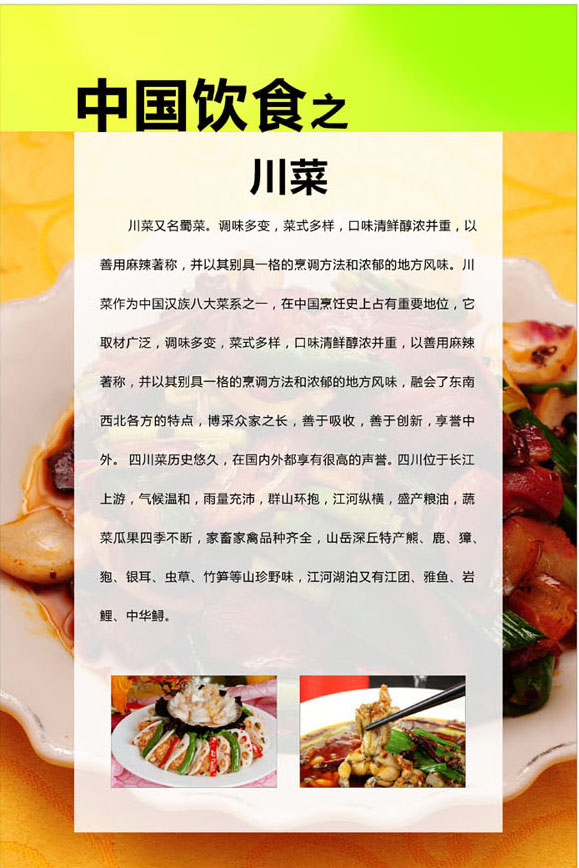一、中国八大菜系英语怎么翻译
中国八大菜系:
1,鲁菜Shandong cuisine
雍鲁菜讲究原料质地优良,以盐提鲜,以汤壮鲜,调味讲求咸鲜纯正,突出本味 容华贵、中正大气、平和养生。
容华贵、中正大气、平和养生。
Yonglu cuisine pays attention to the quality of raw materials, to salt fresh, soup strong and fresh, seasoning salty fresh and pure, highlighting the original flavor. Junwaki, Zhong Zheng's atmosphere, peace and health.
2,川菜Sichuan cuisine
调味多变,菜式多样,口味清鲜醇浓并重,以善用麻辣调味。
The seasoning is varied, the dishes are diverse, and the taste is fresh and fresh.
3,粤菜Cantonese cuisine
选料精细,清而不淡,鲜而不俗,嫩而不生,油而不腻。擅长小炒,要求掌握火候和油温恰到好处。还兼容许多西菜做法,讲究菜的气势、档次。
The choice of materials is fine, clear and not light, fresh and not vulgar, tender and not raw, oily but not greasy. He is good at stir frying, and requires proper temperature and temperature. It is also compatible with many Western dishes, paying attention to the momentum and grade of dishes.
4,苏菜Chinese Cabbage
用料严谨,注重配色,讲究造型,四季有别。
Strict material, color matching and modeling. Four seasons are different.
5,闽菜Fujian Cuisine
尤以“香”、“味”见长,其清鲜、和醇、荤香、不腻的风格。三大特色,一长于红糟调味,二长于制汤,三长于使用糖醋。
Especially with "fragrant" and "flavor", they are fresh, sweet, fragrant, and not greasy. Three characteristics, one is longer than the seasoning of red grains, two is longer than the soup, three is longer than the sweet and sour.
6,徽菜Huizhou cuisine
擅长烧、炖、蒸,而爆、炒菜少,重油、重色,重火功。重火工是历来的,其独到之处集中体现在擅长烧、炖、熏、蒸类的功夫菜上,不同菜肴使用不同的控火技术,形成酥、嫩、香、鲜独特风味,其中最能体现徽式特色的是滑烧、清炖和生熏法。
It is good at burning, stewing, steaming, and blasting, cooking less, heavy oil, heavy color, heavy fire work. Heavy pyrotechnics has a long history. Its originality is mainly embodied in Kung Fu dishes which are good at cooking, stewing, smoking and steaming. Different dishes use different fire control techniques to form crisp, tender, fragrant and fresh flavors. The most distinctive emblem style is slippery, stewing and raw smoking.
7,湘菜Hunan cuisine
口味多变,品种繁多;色泽上油重色浓,讲求实惠;香辣、香鲜、软嫩。重视原料互相搭配,滋味互相渗透。湘菜调味尤重酸辣。相对而言,湘菜的煨功夫更胜一筹,几乎达到炉火纯青的地步。煨,在色泽变化上可分为红煨、白煨,在调味方面有清汤煨、浓汤煨和奶汤煨。小火慢炖,原汁原味。
The flavour is changeable, the variety is various, the color and luster is heavy, the color is thick, pays attention to the actual benefit; spicy, fragrant, fresh, soft tender. Attention should be paid to the matching of raw materials and flavor. The flavor of Hunan cuisine is extremely sour and spicy. Relatively speaking, the simmering skills of Hunan cuisine are better than those of almost all of them. In terms of color change, it can be divided into red simmer and white simmer. In terms of seasoning, there are clear soup simmer, thick soup simmer and milk soup simmer. Simmer with little fire, original flavor.
8,浙菜zhejiang cuisine
菜式小巧玲珑,清俊逸秀,菜品鲜美滑嫩,脆软清爽。运用香糟调味。烹调技法丰富,尤为在烹制海鲜河鲜有其独到之处。口味注重清鲜脆嫩,保持原料的本色和真味。菜品形态讲究,精巧细腻,清秀雅丽。
The dishes are small and exquisite, Qing Jun Yi Xiu, the dishes are delicious and tender, crisp, soft and refreshing. Seasoning with fragrant grains. Cooking techniques are abundant, especially in Cooking Seafood and fresh food. The flavour should be fresh and crisp, and keep the natural and true flavor of the ingredients. The dishes are exquisite, delicate, delicate and elegant.
拓展知识
菜系,又称“帮菜”,是指在选料、切配、烹饪等技艺方面,经长期演变而自成体系,具有鲜明的地方风味特色,并为社会所公认的中国饮食的菜肴流派。
中国饮食文化的菜系,是指在一定区域内,由于气候、地理、历史、物产及饮食风俗的不同,经过漫长历史演变而形成的一整套自成体系的烹饪技艺和风味,并被全国各地所承认的地方菜肴。
参考资料:中国八大菜系-百度百科
二、八大菜系英语 八大菜系的英语怎么说
八大菜系
这个词语
用英语表达
翻译为 : Eight major cuisines.
三、中国8大菜系都有的英语菜单 每个菜系都得有4样 主食、酒水,还有两样菜 急,在线等 感谢
eight regional cuisines:8大菜系
Sichuan cuisine 川菜 ; Guangdong cuisine 粤菜。
Zhejiang cuisine 浙菜 Jiangsu/Huaiyang cuisine 淮阳菜系;
Anhui cuisine 皖菜, Fujian cuisine 闽菜,
Hunan cuisine 湘菜; shandong cuisine 鲁菜;
四、八大菜系中各菜系的英文是什么?急求大虾
鲁菜 Shandong Cuisine
川菜 Sichuan Cuisine
苏菜 Jiangsu Cuisine
粤菜 Guangdong Cuisine
闽菜 Fujian Cuisine
浙菜 Zhejiang Cuisine
湘菜 Hunan Cuisine
徽菜 Anhui Cuisine
China covers a large territory and has many nationalities, hence a variety of Chinese food with different but fantastic and mouthwatering flavor. Since China's local dishes have their own typical characteristics, generally, Chinese food can be roughly divided into eight regional cuisines, which has been widely accepted around. Certainly, there are many other local cuisines that are famous, such as Beijing Cuisine and Shanghai Cuisine.
Shandong Cuisine
Consisting of Jinan cuisine and Jiaodong cuisine, Shandong cuisine, clear, pure and not greasy, is characterized by its emphasis on aroma, freshness, crispness and tenderness. Shallot and garlic are usually used as seasonings so Shangdong dishes tastes pungent usually. Soups are given much emphasis in Shangdong dishes. Thin soup features clear and fresh while creamy soup looks thick and tastes strong. Jinan cuisine is adept at deep-frying, grilling, frying and stir-frying while Jiaodong division is famous for cooking seafood with fresh and light taste.
Shandong is the birthplace of many famous ancient scholars such as Confucious and Mencius. And much of Shandong cuisine's history is as old as Confucious himself, making it the oldest existing major cuisine in China. But don't expect to gain more wisdom from a fortune cookie at a Shandong restaurant in the West since fortune cookies aren't even indigenous to China.
Shandong is a large peninsula surrounded by the sea to the East and the Yellow River meandering through the center. As a result, seafood is a major component of Shandong cuisine. Shandong's most famous dish is the Sweat and Sour Carp. A truly authentic Sweet and Sour Carp must come from the Yellow River. But with the current amount of pollution in the Yellow River, you would be better off if the carp was from elsewhere. Shandong dishes are mainly quick-fried, roasted, stir-fried or deep-fried. The dishes are mainly clear, fresh and fatty, perfect with Shandong's own famous beer, Qingdao Beer
Sichuan Cuisine
Sichuan Cuisine, known often in the West as Szechuan Cuisine, is one of the most famous Chinese cuisines in the world. Characterized by its spicy and pungent flavor, Sichuan cuisine, prolific of tastes, emphasizes on the use of chili. Pepper and prickly ash also never fail to accompany, producing typical exciting tastes. Besides, garlic, ginger and fermented soybean are also used in the cooking process. Wild vegetables and animals are usually chosen as ingredients, while frying, frying without oil, pickling and braising are applied as basic cooking techniques. It cannot be said that one who does not experience Sichuan food ever reaches China.
If you eat Sichuan cuisine and find it too bland, then you are probably not eating authentic Sichuan cuisine. Chili peppers and prickly ash are used in many dishes, giving it a distinctively spicy taste, called ma in Chinese. It often leaves a slight numb sensation in the mouth. However, most peppers were brought to China from the Americas in the 18th century so you can thank global trade for much of Sichuan cuisine's excellence. Sichuan hot pots are perhaps the most famous hotpots in the world, most notably the Yuan Yang (mandarin duck) Hotpot half spicy and half clear.
Guangdong Cuisine
Cantonese food originates from Guangdong, the southernmost province in China. The majority of overseas Chinese people are from Guangdong (Canton) so Cantonese is perhaps the most widely available Chinese regional cuisine outside of China.
Cantonese are known to have an adventurous palate, able to eat many different kinds of meats and vegetables. In fact, people in Northern China often say that Cantonese people will eat anything that flies except airplanes, anything that moves on the ground except trains, and anything that moves in the water except boats. This statement is far from the truth, but Cantonese food is easily one of the most diverse and richest cuisines in China. Many vegetables originate from other parts of the world. It doesn't use much spice, bringing out the natural flavor of the vegetables and meats.
Tasting clear, light, crisp and fresh, Guangdong cuisine, familiar to Westerners, usually chooses raptors and beasts to produce originative dishes. Its basic cooking techniques include roasting, stir-frying, sauteing, deep-frying, braising, stewing and steaming. Among them steaming and stir-frying are more commonly applied to preserve the natural flavor. Guangdong chefs also pay much attention to the artistic presentation of dishes.
Fujian Cuisine
Consisting of Fuzhou Cuisine, Quanzhou Cuisine and Xiamen Cuisine, Fujian Cuisine is distinguished for its choice seafood, beautiful color and magic taste of sweet, sour, salty and savory. The most distinct features are their "pickled taste".
Jiangsu Cuisine
Jiangsu Cuisine, also called Huaiyang Cuisine, is popular in the lower reach of the Yangtze River. Aquatics as the main ingredients, it stresses the freshness of materials. Its carving techniques are delicate, of which the melon carving technique is especially well known. Cooking techniques consist of stewing, braising, roasting, simmering, etc. The flavor of Huaiyang Cuisine is light, fresh and sweet and with delicate elegance. Jiangsu cuisine is well known for its careful selection of ingredients, its meticulous preparation methodology, and its not-too-spicy, not-too-bland taste. Since the seasons vary in climate considerably in Jiangsu, the cuisine also varies throughout the year. If the flavor is strong, it isn't too heavy; if light, not too bland.
Zhejiang Cuisine
Comprising local cuisines of Hangzhou, Ningbo and Shaoxing, Zhejiang Cuisine, not greasy, wins its reputation for freshness, tenderness, softness, smoothness of its dishes with mellow fragrance. Hangzhou Cuisine is the most famous one among the three.
Hunan cuisine
Hunan cuisine consists of local Cuisines of Xiangjiang Region, Dongting Lake and Xiangxi coteau. It characterizes itself by thick and pungent flavor. Chili, pepper and shallot are usually necessaries in this division.
Anhui Cuisine
Anhui Cuisine chefs focus much more attention on the temperature in cooking and are good at braising and stewing. Often hams will be added to improve taste and sugar candy added to gain
中国地域辽阔,民族众多,因此各种中国饮食口味不同,却都味美,令人垂涎。因为中国地方菜肴各具特色,总体来讲,中国饮食可以大致分为八大地方菜系,这种分类已被广为接受。当然,还有其他很多著名的地方菜系,例如北京菜和上海菜。
山东菜系
山东菜系,由济南菜系和胶东菜系组成,清淡,不油腻,以其香,鲜,酥,软而闻名。因为使用青葱和大蒜做为调料,山东菜系通常很辣。山东菜系注重汤品。清汤清澈新鲜,而油汤外观厚重,味道浓重。济南菜系擅长炸,烤,煎,炒,而胶东菜系则以其烹饪海鲜的鲜淡而闻名。
山东是许多著名学者的故乡,例如孔夫子和孟子。许多山东菜的历史和孔夫子一样悠久,使得山东菜系成为中国现存的最古老的主要菜系之一。但是不要期望在西方国家的山东菜馆里从签饼(中国餐馆的折叠形小饼,内藏有预测运气话语的纸条)获得更多的好运气,因为签饼在中国也不是本土的。
山东是个巨大的被向东流去的大海环绕的半岛,黄河曲折的流经其中部。因此海鲜是山东菜系的主要构成。山东最著名的菜肴是糖醋鲤鱼。正宗的糖醋鲤鱼必须打捞自黄河。但是因为现在黄河的众多污染,其他地方的鲤鱼更好一些。山东菜主要是速炸,烧烤,炒或深炸。菜肴清新肥美,搭配山东本地的著名啤酒——青岛啤酒就完美了。
四川菜系
四川菜系,是世界上最著名的中国菜系之一。四川菜系以其香辣而闻名,味道多变,着重使用红辣椒,搭配使用青椒和prickly ash,产生出经典的刺激的味道。此外,大蒜,姜和豆豉也被应用于烹饪过程中。野菜和野禽常被选用为原料,油炸,无油炸,腌制和文火炖煮是基本的烹饪技术。没有品尝过四川菜的人不算来过中国。
如果你吃四川菜,发现它过于柔和,那么你可能吃的不是正宗的四川菜。红绿辣椒被用在许多菜肴中,带来特别的辣味,在中国文字里叫麻,通常会在口中留下麻木的感觉。然而,多数青椒是在18世纪从美国传入中国的,因此你应当为四川菜的精妙而感谢全球贸易。四川火锅也许是世界上最出名的火锅,尤其是半辣半清的鸳鸯火锅。
广东菜系
广东菜源自于中国最南部的省份广东省。大多数华侨来自广东,因此广东菜也许是国外最广泛的中国地方菜系。
广东人热衷于尝试用各种不同的肉类和蔬菜。事实上,中国北方人常说,广东人吃天上飞的,除了飞机;地上爬的,除了火车;水里游的,除了船儿。这一陈述很不属实,但是广东菜是各类丰富的中国菜系之一。使用很多来自世界其他地方的蔬菜,不大使用辣椒,而是带出蔬菜和肉类自身的风味。
广东菜系,味道清,淡,脆,鲜,为西方人所熟知,常用猛禽走兽来烹饪出有创意的菜肴。它的基础烹饪方法包括烤,炒,煸,深炸,烤,炖和蒸。其中蒸和炒最常用于保存天然风味。广东厨师也注重于菜肴的艺术感。
福建菜系
福建菜系由福州菜,泉州菜,厦门菜组成,以其精选的海鲜,漂亮的色泽,甜,酸,咸和香的味道而出名。最特别的是它的“卤味”。
江苏菜系
江苏菜,又叫淮阳菜,流行于在淮阳湖下流。以水产作为主要原料,注重原料的鲜味。其雕刻技术十分珍贵,其中瓜雕尤其著名。烹饪技术包括炖,烤,焙,煨等。淮阳菜的特色是淡,鲜,甜,雅。江苏菜系以其精选的原料,精细的准备,不辣不温的口感而出名。因为江苏气候变化很大,江苏菜系在一年之中也有变化。味道强而不重,淡而不温。
浙江菜系
浙江菜系由杭州菜,宁波菜,绍兴菜,组成,不油腻,以其菜肴的鲜,柔,滑,香而闻名。杭州菜是这三者中最出名的一个。
湖南菜系
湖南菜系由湘江地区,洞亭湖和湘西的地方菜肴组成。它以其极辣的味道为特色。红辣椒,青辣椒和青葱在这一菜系中的必备品。
安徽菜系
安徽厨师注重于烹饪的温度,擅长煨炖。通常会加入火腿和方糖来改善菜肴的味道。
五、八大菜系的英文翻译
No. 1 Sichuan Cuisine 川菜
Specialties Include: 特别推荐:
Pockmarked bean curd 麻婆豆腐
Chicken cubes with peanuts 宫保鸡丁
Pork shreds with fishy flavour 鱼香肉丝
Translucent beef slices 水晶牛片
Guangdong cuisine 粤菜
Specialties include: 特别推荐
Roasted sucking pig 烤乳猪
Fricassee three kinds of snakes and cat
三蛇龙虎凤大会
Steamed turtle with chives sauce
虾夷葱酱汁清炖甲鱼
King snake with bamboo slices 蛇王炒鸡丝
Gourd cups 汤类
No. 3 Shandong Cuisine 山东菜系
Dezhou grilled chicken 炙鸡
Bird’s nest in a clear soup
Quick-boiled clam 龙凤酸辣汤
Lotus flower and shrimp 青辣椒镶虾
No. 4 Huaiyang Cuisine (also known as Weiyang Cuisine) 苏州菜
Yincai vegetalbes cooked with chicken slices 鸡汤煮干丝
Crab meat & minced pork ball in casserole 清炖蟹粉
Chicken mousse broth with fresh corn
Squid with crispy rice crust 桃花饭
No. 5 Zhengjiang Cuisine 浙江菜系
Dong po pork 东坡肉
West lake vinegar fish 西湖醋鱼
Shelled shrimps with dragon well tea leaves 龙井虾仁
Beggar’s chicken( a whole chicken roasted in a caked mud) 叫花鸡
No. 6 Fujian cuisine 福建菜系
Sea food and poultry in casserole 海鲜砂锅
Steamed chicken ball with egg-white 叉烧芙蓉
Fried prawn shaped as a pair of fish 桔汁加吉鱼
Crisp pomfret with litchi 糖醋里脊
No.7 Hunan Cuisine 湖南菜系
Dong’an chicken 东安子鸡
Braised dried pork with eel slices 板栗红烧肉
Steamed turtle 清蒸甲鱼
Spring chicken with cayenne pepper 碧绿花子鸡和麻辣鸡丁
No. 8 Anhui Cuisine 安徽菜
Huangshan stewed pigeon 黄山乳鸽
Gourd duck 葫芦鸭子
Fricassee pork sinew with egg white 芙蓉海参
Crisp pork with pine nuts松子熏肉
六、八大菜系的英文怎么说
你应该是问八大菜系分别怎么说吧 追问: 恩 是的是的 回答: Guangdong Cuisine 粤菜系 Fujian Cuisine 闽菜系 Jiangsu Cuisine 江苏菜 系 Zhejiang Cuisine 浙江菜 系 Hunan cuisine 湘菜系 Anhui Cuisine 安徽菜 系 Shandong Cuisine 鲁菜系 Sichuan Cuisine 川菜系






